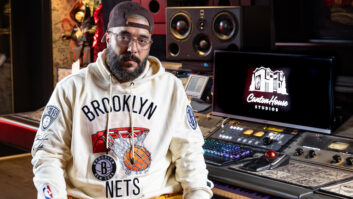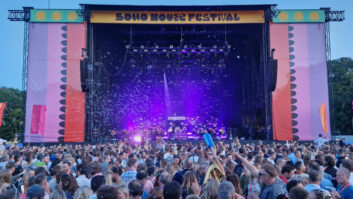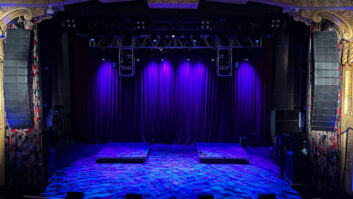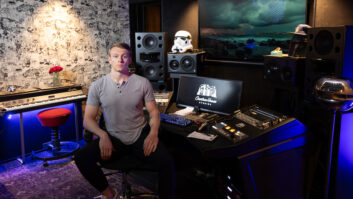Eric Hart recently outfitted his private production studio, Glas Haus, with extensive acoustic treatments from Delta H Design.

Los Angeles, CA—After spending more than three years looking for a new house into which he could relocate his private production studio, Eric Hart was able to move out of his stereotypical black-box room and into a space flooded with natural light. Faced with turning a room with a cement floor, a sloping ceiling and a lot of glass into an acceptable work environment, Hart called on Hanson Hsu at Delta H Design, Inc. (DHDI) to acoustically treat the space.
“It’s the best money I’ve spent— and I’ve spent lots and lots of money on acoustics before,” says Hart, who has operated Glaus Haus Studios for about 20 years. Acoustic treatment can often be hit or miss, he continues. “You hope it’s going to sound better, but it’s always a letdown. You put in a cloud and new material and think that it’s going to be the thing that fixes it, then you have a problem somewhere else. But this is great.”
The treated room has even made a noticeable difference to the efficacy of some of the audio tools Hart uses. “I have the iZotope mastering plug-in. It was useless in the other studio; I never really liked it. But now I like it, because I can actually hear it and use it properly.”
DHDI treated less than half of the surface area of the walls and ceiling, installing a custom-designed layout of ZR Micro and ZR Sample Rate 8 Bit panels, which incorporate wave splitting technology developed by the company that produces results that belie the profile of the products. “This is version two of the ZR Micro, which is only an inchand-a-quarter thick,” reports Hsu. The original design was an inchand-a-half deep.
DHDI’s solutions can eliminate any need to consider the effects of glass in a room, it seems. The Glaus Haus control room, not a huge space, has three full-size glass doors, but Hsu observes, “As evidenced by this room, glass isn’t an issue any more. We just make it so that you don’t hear it. Leave the glass alone, treat the rest of the room.”
Hart, a producer, composer, musician, remixer and engineer who leans more toward electronica and ambient music, comments, “When I send things out to get mastered, mastering engineers are coming back and saying, ‘What did you do?’ The resolution is at mastering resolution. And you have that translation, so you’re not second-guessing. Projects need very few tweaks.”
The live room, adjacent to the pool and also treated with ZR Micro and ZR Sample Rate 8 Bit panels, is extremely conducive to recording despite its wall of glass. “I had a tracking session with [guitarist] Warren Cuccurullo,” Hart recalls. “We threw it together—two ribbon mics, SM57, Marshall stack. He plugs in and records; they were great takes. There was a whole wall of glass out there in the tracking room, with just one curtain closed, and the whole house was open to the live room. Someone who used to work at Ocean Way was over and said, ‘That sounds like Ocean Way!’ The ZR Acoustics technology has such high resolution it allowed us to record in a Mid-Century Modern on a hill overlooking the San Fernando Valley with phenomenal results.”
It probably also helps that Hart has amassed a collection of equipment capable of supporting the highest audio quality. Monitoring is via a pair of ADAM Audio 3A near fields and a pair of Sub12s. A console housing a Mackie control surface also includes racks of A-Designs, API, Empirical Labs, Focusrite, Kush Audio and other signal processers.
In one outboard rack sits an EQP-1A, LA-2P and a blue-faced 1176, all looking remarkably well preserved. As it turns out, Hart, a Ph.D, built all three from scratch.
“You want a certain sound. The new stuff doesn’t sound good. The old stuff, some of it sounds good and some of it doesn’t. You know you’re going to go through and fix it anyway, so why not just build it?” he says, modestly.
But perhaps key to the sounds coming out of Glaus Haus is the Burl Audio B80 Mothership converter system. “Everything goes out to analog and back in. It’s an interesting idea for electronica.”
In May, Krister Linder, a Swedish electronica artist based in New York, completed his latest album at Glaus Haus. “All the Krister Linder tracks were done on a laptop, and it doesn’t sound like it; they were all sent out and summed in the Burl,” says Hart.
A recent project featuring tracks recorded in 1992 by Cuccurullo and Sultan Khan, the late Indian master musician, tested Hart’s engineering chops: “Everything was played in free time, and the second half of this project is a remix, so I spent a year thinking about how I was going to bring a 15-minute orchestrated Indian piece into time. I put it on the grid, looked at the relative time of each bar, then used markers and brought the tempo in on every bar. And in that particular song, it changes time signature every bar. But it was really important to preserve the way it felt.” The album is scheduled for release in July.
DHDI
www.deltahdesign.com






